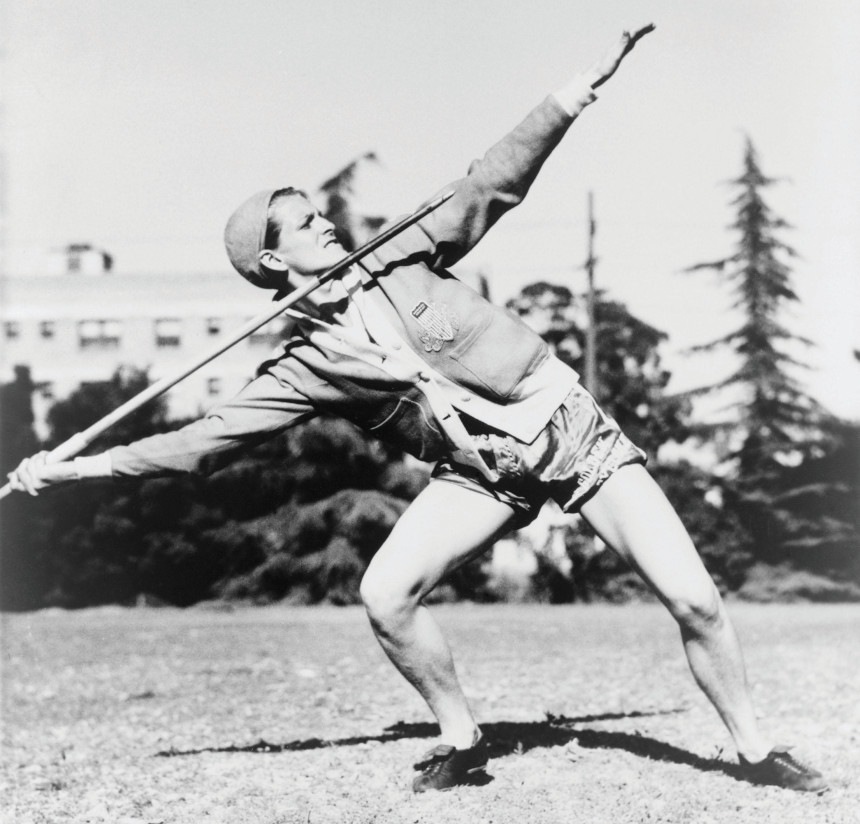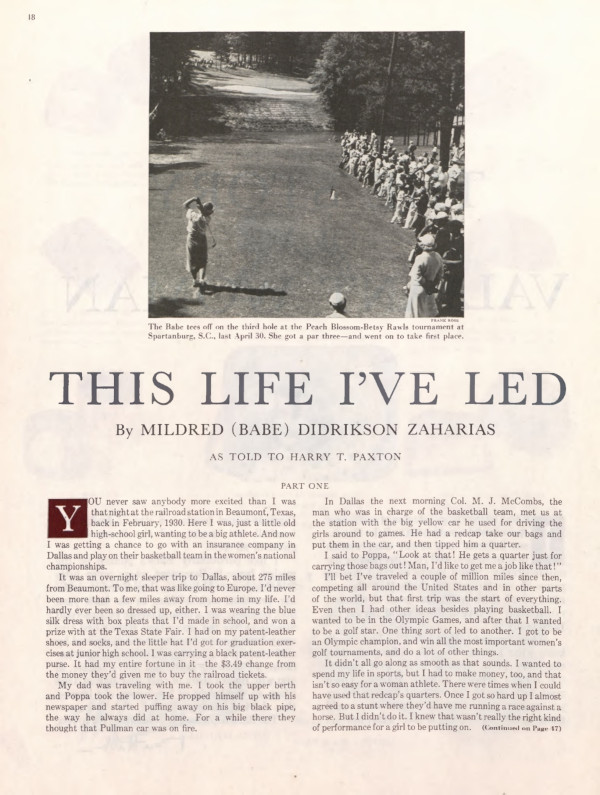—This excerpt is from “This Life I’ve Led” by Babe Didrikson (five-part series), June 25–July 23, 1955. As told to Harry T. Paxton.
Before I was even out of grade school, I knew what I wanted to be when I grew up. My goal was to be the greatest athlete that ever lived. My dad helped to swing me in that direction. He’d tell us about the sports stars. I read the sports pages myself. Even then I was interested in the famous golfers.
When the 1928 Olympic Games came along, I heard and read so much about them that I got all steamed up. I said, “Next year I’m going to be in the Olympics myself.” Poppa explained to me that they were four years apart.
My main idea in any kind of competition always has been to go out there and cut loose with everything I’ve got. I’ve never been afraid to go up against anything. I’ve always had the confidence that I was capable of winning [as in] July, 1932, at the women’s combined national championships and Olympic tryouts in track and field. It was one of those days in an athlete’s life when you feel you could fly. You’re like a feather floating in air. Out of ten individual events on the program I was entered in eight, including a couple I’d hardly ever done before — the shot put and the discus throw.
Winning that 1932 national-championship track meet singlehanded was the thing that first made my name big — that and the Olympic Games that followed. There were only five individual track and field events for women on the Olympic program that year, and I was in three of them, which was the most they would allow one person to enter — the javelin, the hurdles, and the high jump.
On the train going out from Chicago to Los Angeles, where the Olympics were being held that year, most of the girls sat around watching the scenery and playing cards and gabbing. I was busy taking exercises and doing my hurdle bends and stuff. I’d practice in the aisle. Several times a day I’d jog the whole length of the train and back. People in the other cars took to calling out, “Here comes the Babe again!”
Other girls would say to me, “Why don’t you take it easy for a while?” But I’d had my heart set on being in these Olympics from the time I first heard about them. I wanted to be sure I was in shape.
It was a wonderful thrill to march into the Olympic Stadium in the parade on opening day, but to tell you the truth, I couldn’t enjoy the ceremonies much after we got out there. We all had to wear special dresses and stockings and white shoes that the Olympic Committee had issued to us. We had to stand there in a hot sun for about an hour and a quarter while a lot of speeches and things went on. And my feet were hurting more and more. Pretty soon I slipped my feet out of my shoes. Then another girl did. By the end, I think everybody had their shoes off.
I was in the javelin throw that first day, and it didn’t get started until late afternoon. Shadows were coming up over the stadium, and it was getting pretty cool. There were too many of us to risk taking any long, warm-up throws. All you could do was throw the spear into the ground, which I never thought gave you the right swing. I tried it, and I almost put it in a German girl’s leg. So I thought I’d better stop.
The event started. They had a little flag stuck in the ground out there to show how far the world’s record was. When my first turn came, I set out to throw the javelin right over the top of that flag. I hadn’t warmed up enough. As I let the spear go, my hand slipped off the cord on the handle. Instead of arching the way it usually did, that javelin went out there like a peg from home to second base. It looked like it was going to go right through the flag. But it kept on about 14 feet past it for a new world’s record of 143 feet, 4 inches. My first throw stood up to give me the gold medal for first place.

In the finals the following day I was so anxious to break the record again that I jumped the gun, and they called us all back. Now, in Olympic competition, if you jump the gun a second time they disqualify you. I didn’t want that to happen, so I held back on the next start until I saw everybody taking off. It wasn’t until the fifth hurdle that I caught up, and I just did beat out Evelyne Hall, of Chicago. If it was horse racing, you’d say I won by a nose. Even with the late start, I beat my record again at 11.7 seconds.
Now all I needed was to win the high jump the next day to make a clean sweep of three events. My big competition was Jean Shiley, who had tied with me out in Evanston. They kept moving the bar higher and higher, until it was at 5 feet, 5 inches, nearly two inches above the world’s record. Jean and I both cleared it without much trouble.
Then they put it up to 5 feet, 5 3/4 inches. I sailed way over it, but as I was coming down, my left foot brushed the bottom of one of the uprights just hard enough to make the crossbar fall off. So they dropped the bar down a half inch. Jean Shiley got over it all right, and I did too. Then the judges disallowed my jump. They ruled that I had dived, which meant that my head crossed the bar before my feet did. Today that wouldn’t matter, but in 1932 it was against the rules. Too many exciting things were happening around then for me to worry too long about winding up second in the Olympic high jump.
When [sportswriter] Grantland Rice invited me out to the Brentwood course during the Olympics, I’d never played a round of golf in my life. There were three other writers there with Granny. While they were having some coffee before we teed off, I ducked out and had me a quick session with the club professional, who lent me some clubs. He showed me as much as he could in a few minutes about the stance and the grip and the swing.
Well, I got up there on the first tee and hit the ball, and it sailed straight out about 240 yards. I outdrove all the men on that first hole. Of course, I had some bad shots too. I’ve read since that my score that day was 86.
I’d thought about being a golfer before, but I think that was the day that really determined me on it. Grantland Rice told me and wrote in his column that he’d never seen a woman who could hit a golf ball the way I did,
—“This Life I’ve Led” (five-part series), June 25–July 23, 1955

This article is featured in the July/August 2021 issue of The Saturday Evening Post. Subscribe to the magazine for more art, inspiring stories, fiction, humor, and features from our archives.
Featured image: Everett Collection Historical / Alamy Stock Photo
Become a Saturday Evening Post member and enjoy unlimited access. Subscribe now



